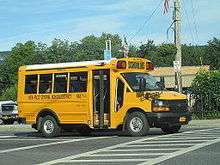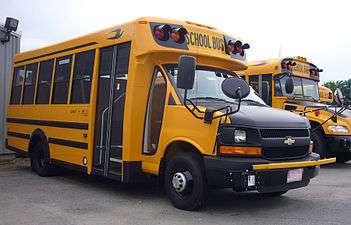Blue Bird Micro Bird
| Blue Bird Micro Bird | |
|---|---|
| Overview | |
| Manufacturer |
Blue Bird Body Company (1975-1992) Blue Bird Corporation (1992-2010) Micro Bird, Inc. (Blue Bird/Girardin joint venture) (2010-present) |
| Production |
1975–2010 (Blue Bird Micro Bird) 2010-present (Micro Bird by Girardin) |
| Assembly | see listing |
| Designer | Blue Bird |
| Body and chassis | |
| Class | Type A |
| Body style |
School bus/MFSAB Mini bus |
| Layout |
|
| Platform | see listing |
| Related | Blue Bird MB-II/MB-IV |
| Chronology | |
| Successor | Micro Bird by Girardin |
The Blue Bird Micro Bird is a school bus produced in the United States and Canada by Blue Bird Corporation since 1975. It is based on a cutaway van chassis, with passenger capacity ranging from 10 to 30 passengers.[1] The Micro Bird was originally designed as a school bus, but it is also sold as a MFSAB (Multi-Function School Activity Buses). MFSABs are alternatives to 15-passenger vans that along with school systems that have come into use by child care centers and other organizations due to changing safety regulations.
Since 2010, the current version of the Micro Bird has been produced in Quebec as part of a joint venture with Blue Bird and Girardin Minibus, called Micro Bird, Inc.
Background
During the 1960s and early 1970s, small school buses in the United States and Canada were heavily derived from production vehicles. Along with full-size vans such as the Dodge A100, the Chevrolet ChevyVan/GMC Handi-Van, and the Ford Econoline, large "carryall" SUVs were also used (such as the Chevrolet Suburban/GMC Carryall and International Travelall). To increase the safety of small vehicles transporting students, bus manufacturers chose to design a bus body that mated a production vehicle chassis with a body designed with the same reinforced internal structure of a large school bus.
In 1973, Wayne Corporation introduced the Wayne Busette, the first school bus to successfully use a cutaway van chassis with a school bus body. To increase its stability over a van or an SUV, the Busette chassis (the Chevrolet/GMC G30) utilized a dual rear-wheel axle.
As a response to the Busette, Blue Bird designers sought to develop their own body for a cutaway chassis. Dubbed the Micro Bird, the body distinguished itself from the Busette with several key features, many of them geared towards aiding the loading/unloading process. Rather than use the stock van door as part of the entrance, Blue Bird designed the Micro Bird body to utilize a standard school bus door, the same design used on Conventional and All American full-size buses. Ahead of the entry door, two windows were added, further aiding visibility; to this day, this layout is copied in virtually all cutaway-chassis buses. While the Busette was designed with its own body from the ground up, the Micro Bird shared the design of its body with the Conventional; the key change was its narrower width to properly fit the van chassis.
Design overview
Body

For many years, the main body design for the Micro Bird would remain largely unchanged. The primary markets for the Micro Bird were districts transporting small children or special needs students (the Micro Bird was popular with the "Handy Bus" option, with wheelchair lifts fitted). In the late 1980s, Blue Bird changed the design of the loading-zone window from 2 pieces of glass to a single large piece. Following the redesign of the General Motors full-size van line, for 1997, Micro Birds were given a new roofline, with the front of the roof extending over the windshield. Other parts of the redesign included a change of the curvature of the roof, allowing for more headroom at the corners; this was a feature adopted from the TC/1000, another bus designed towards special-needs students.
Following the end of the Girardin joint venture in 1999, Blue Bird developed its own Micro Bird body designed for single rear-wheel chassis in the early 2000s.
After Blue Bird formed its second joint venture with Girardin in late 2009, Blue Bird ended production of the original Micro Bird at the end of the 2010 model year. After 35 years of production, the Micro Bird was the longest-produced Blue Bird after the Conventional/CV200 and the All American. It would also be the final Blue Bird-produced model to have its chassis production outsourced to another manufacturer.
Chassis
Prior to the redesign of the Ford E-Series, the Micro Bird was produced nearly exclusively on the Chevrolet/GMC G30 dual rear-wheel cutaway van chassis. Alongside the MB-Series, the Micro Bird expanded chassis availability to the Ford E-Series starting in 1992. From 1994 to 1996, General Motors offered a second chassis for the Micro Bird; to produce a heavier-duty version of its cutaway van, GM placed the cab of the G30 van on the higher-GVWR frame of the P30 "step-van" chassis; these versions are distinguished by an extended nose with a tilt-forward hood. The heavy-duty GM chassis was discontinued after 1996, as the company redesigned its full-size van line and the new Chevrolet Express/GMC Savana did not have bodywork designed to fit on the P30 chassis.
In 2014, Blue Bird became the first North American bus manufacturer to develop a body for the Ford Transit 350/350HD chassis that is replacing the Ford E-Series.[2] Using a version of the Girardin MB body (Micro Bird T-Series), both single and dual rear-wheel configurations are produced.
Micro Bird by Girardin


Blue Bird and Quebec-based manufacturer Girardin Minibus have produced cutaway school bus bodies in two separate joint ventures, from 1992 to 1999 and from 2009 to present. The first joint venture was a distribution agreement between the two companies; Blue Bird served as the United States distributor of the Girardin MB-II and MB-IV buses (with "Blue Bird MBII/IV by Girardin" badging).
Introduced in 1991, the MB-IV was a dual rear wheel design similar to the Micro Bird while the MB-II was of a single rear wheel design. The MB-II differed from other single rear wheel designs of the time in that its body was a full cutaway bus body and not a conversion of a van to a bus. The MB became one of the first widespread uses of the Ford E-Series chassis by Blue Bird alongside the GM G30 chassis, which was also available.
In 2009, Girardin Minibus entered into a joint venture with Blue Bird. The partnership, named Micro Bird, Inc., consolidated all Type A school bus production at the Girardin facilities in Drummondville, Quebec, Canada. As part of the agreement, all future Type A school buses were branded Blue Bird Micro Bird by Girardin while Blue Bird itself concentrated on production of full-size Type C and D buses.[3] The MB-II made its return, joined by the dual rear-wheel G5, which replaced the MB-IV in 2005.
In October 2014, a third model was introduced, the Micro Bird T-Series. Using a body similar to the MB-II, the T-Series is the first school bus in North America to make use of the Ford Transit chassis that is replacing the Ford E-Series.[2]
Chassis Manufacturers
Micro Bird Chassis Manufacturers
| |||||||||||||||||||||||||||
Assembly
The Micro Bird was assembled at the following manufacturing facilities:
- Blue Bird Body Company in Fort Valley, Georgia (1975–2010)
- Blue Bird Midwest in Mount Pleasant, Iowa (1975–2002)
- Blue Bird Canada in Brantford, Ontario, Canada (1975–2007)
See also
| Wikimedia Commons has media related to Blue Bird Micro Bird. |
References
- ↑ "Product Information-School-Micro Bird-Overview". Blue Bird Corporation. Retrieved 2010-06-23.
- 1 2 "Blue Bird | THE NEW MICRO BIRD T-SERIES BUS LINE DEBUTS AT NAPT". Retrieved 2014-11-18.
- ↑ "Press Releases/BLUE BIRD AND GIRARDIN ANNOUNCE JOINT VENTURE(2009-10-19)". Archived from the original on 2010-07-24. Retrieved 2010-01-23.
- ↑ "Blue Bird | THE NEW MICRO BIRD T-SERIES BUS LINE DEBUTS AT NAPT". Retrieved 2014-11-18.